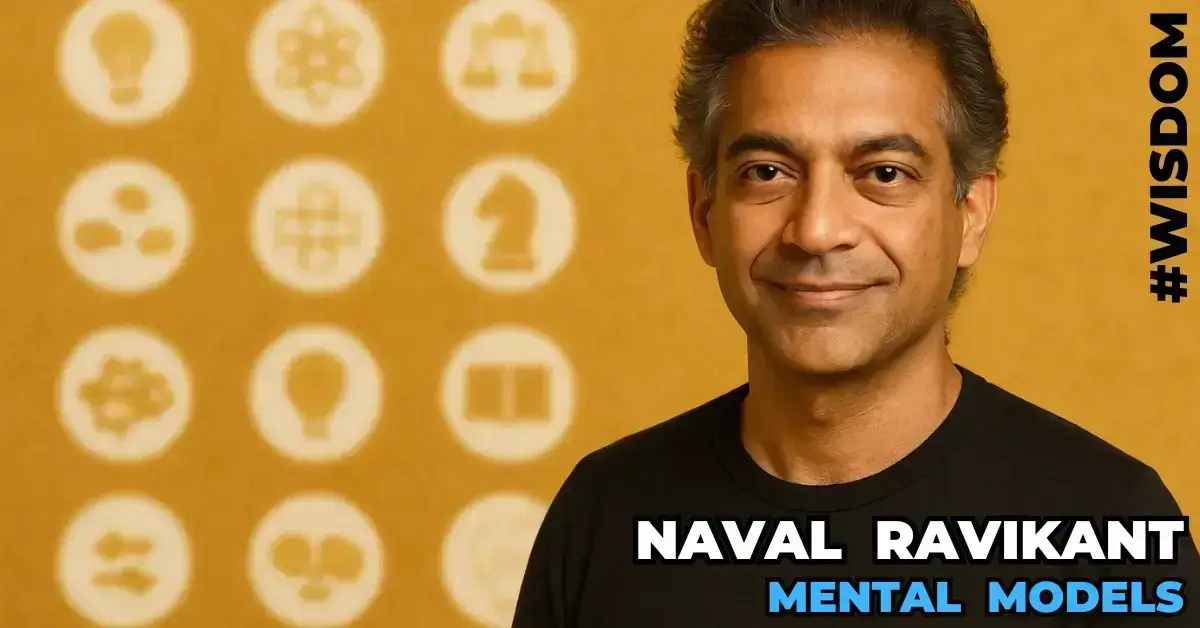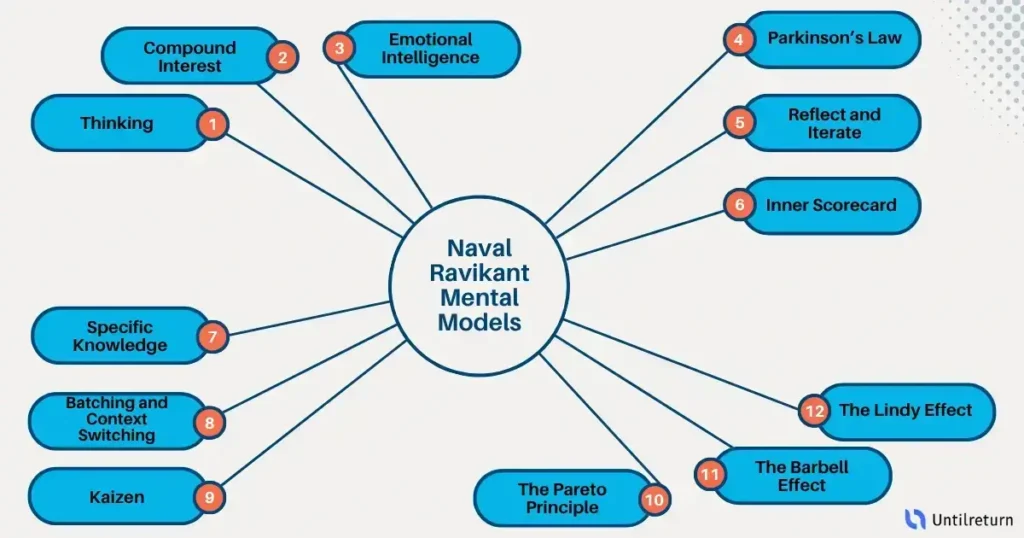How 12 Naval Ravikant Mental Models Made Me 12x Better

“Productivity this, Productivity that” Are you also caught in a whirlwind of ideas on how to improve yourself? Honestly, I feel the same way. I could go on about how toxic growth stifles creativity and how routines can become dull, but fundamentally — there are a few practices I’ve started, and I hope to share them with you as well.
As someone who is very interested in personal growth and reaching their full potential, I’m constantly searching for ideas that can help me improve by just 1%.
Throughout the years, I’ve experimented with numerous productivity hacks, habit-forming methods, and self-improvement techniques. However, none of them seemed to suit me. Whether it was Pomodoro or pushing myself to read — I just couldn’t discover what worked for my routine.
The right mental frameworks can lead to significant improvements in all areas of our lives — from careers and finances to relationships and overall well-being. So when I learned about Naval Ravikant, I read his book and listened to his podcast — it was truly enlightening.
Table of Contents
Who is Naval Ravikant?
In case if you don’t know: Naval Ravikant, an American entrepreneur and investor, is known for co-founding AngelList and investing in over 200 companies in their early stage such as Uber, Twitter, Wish.com, FourSquare, Poshmark, Postmates, Notion, Clubhouse, OpenDNS and so on.

He has had over 70 successful exits and invested in more than 10 Unicorn companies. Additionally, he is a Fellow of the Edmund Hillary Fellowship and shares advice on health, wealth, and happiness through his podcast. I’ve never heard such great insights as the ones he shares in his podcasts and interviews.
Here Are 12 Naval Ravikant Mental Models
I’m thrilled to share the 12 powerful mental models suggested by Naval Ravikant that have truly transformed my life. Using these frameworks has made me more productive, insightful, and effective. I believe they can help you too.
Thinking
This is definitely one of my favorites. You know how sometimes you have many tasks ahead of you — so many that it feels overwhelming. This is where this model has been beneficial for me.
This method involves dividing complex tasks into smaller, manageable ones. You might wonder, “Am I just creating more tasks for myself?”
Not exactly. For instance, if you have a task like “Plan Social Media Posts” — it seems like a huge, daunting task that leaves you unsure of where to begin. But by applying this principle, you can break it down into smaller sub-tasks such as:
- Create 10 posts for Instagram
- Create 10 posts for Twitter
- Schedule posts for Instagram
- Schedule posts for Twitter
When I began using this approach, I no longer felt lost at my desk because I understood that completing each of these smaller tasks would help me finish that one big task.
I was no longer overwhelmed by the uncertainty of my to-do list.
Compound Interest
Although many individuals grasp the concept of compound interest in finance, they frequently overlook its application in other aspects of life, like personal growth and education.
A minor adjustment each day can lead to the development of an entirely new skill. I began to adopt the compound interest mindset, concentrating on making small, steady efforts daily. This could involve initiating a new habit or simply setting weekly objectives to review.
Enhance your abilities to evolve into a significantly improved person.
Emotional Intelligence
Unlike what many think, being a successful creator or achiever isn’t just about having a sharp mind.
A good creator is not only intelligent but also connected to their feelings.
You might be surprised to learn that many people your age or even older have never taken the time to understand their emotions. Building emotional self-awareness and the skill to handle complex situations is equally important.
To achieve this, I began journaling and working on empathy. Initially, I wasn’t very consistent, but over time, I found great joy in reading about my days from 6 months ago or even 2 weeks ago. I reflected on challenges that seemed huge back then but now appear quite minor.
I came to understand that my emotional well-being also requires attention.
Parkinson’s Law
This concept suggests that “tasks take up the time allotted for their completion.”
If you allocate 5 hours for a task, it will take you 5 hours to complete it. Conversely, if you set aside only 2 hours for the same task, you will finish it in 2 hours.
We train our brains to finish tasks, and the longer we give ourselves, the more time it will take. I think this also shows how much time we permit ourselves to develop. Some days, we might finish a task in 3 hours, while on other days it could be 2.5 hours, and sometimes we can do it even faster.
By intentionally setting time limits for some of my tasks and activities, I have managed to use my time more efficiently and also strive to improve at them.
Reflect and Iterate
This is straightforward. You don’t need to do this every day — you’re not a robot. But remember when I mentioned I began journaling, I created some questions to reflect on at the end of the week. These included:
- Reflect on your growth. How far have you come in this journey?
- Write down your reasons — why do you work hard?
- What obstacles or setbacks did I encounter this week?
I made an effort to recall my reasons and recognize that life can be tough. I aimed to regularly pause, evaluate my progress, seek feedback, and adjust my methods.
Inner Scorecard
Instead of looking for approval from others or making comparisons, focus on defining success through your own standards and values. Avoid planning your tasks around thoughts like “what would they think” or “how would they feel.”
Instead, establish your own values such as:
- What are my fundamental values?
- What recent goals have I accomplished?
- What is something I aim to achieve in the next two months?
Read Also: 9 Great Key Takeaways From Naval Ravikant’s Interview On AI
Specific Knowledge
In a world full of information, I’ve realized that focusing on specialized, valuable, and hard-to-copy skills is much more effective than seeking broad knowledge.
Identify your personal strengths and talents. Find out what you love doing and what you are good at. By recognizing your unique skills, you can focus your efforts on becoming an expert in those fields.
Batching and Context Switching
Batching means putting similar tasks together and doing them in specific time slots.
If you’re like me and don’t enjoy time blocking, batching is a good option. You create a list of tasks to complete for the day and group similar ones. For instance, I would allocate time for my office work and during that period, I wouldn’t do anything else like checking my phone or looking at personal emails.
In the same way, for blogging, I would group similar tasks and do the same for household chores.
Eventually, I found that I wasn’t overwhelming myself by juggling multiple tasks at once; instead, I was combining similar tasks that required the same level of mental effort.
Kaizen
I have been doing this for many years, and it is too significant to explain in just a paragraph.
Essentially, Kaizen is a Japanese idea focused on continuous improvement.
Kai means “Change”
Zen means “Good”
The core concept of kaizen is that minor, gradual improvements can result in major long-term benefits. By consistently making small adjustments, we can enhance our skills, processes, and results over time. You could compare this to the Compound effect, but there is much more to it.
The Pareto Principle
The 80/20 rule suggests that about 80% of results come from 20% of the causes.
In other words, if you aim to chop down a tree in 6 hours, dedicate 4 hours to sharpening your tool.
Whether it’s for personal development or a business concept — take time to learn, as you never know when that knowledge will come in handy.
The Barbell Effect
This mental model, made famous by Nassim Nicholas Taleb, indicates that in some cases, it can be beneficial to adopt a strategy that combines extreme risk-taking with a cautious approach.
Many of us tend to play it too safe — perhaps because we feel we cannot afford to make mistakes. These mistakes might jeopardize our jobs, our comfort, or even our way of life. However, occasionally, it’s important to follow your instincts.
There are two kinds of extremes:
- High-Risk, High-Potential Reward: Explain the activities or investments that involve greater risk but also offer the chance for substantial rewards. This could include launching a business or starting a new career. If you believe the potential reward matches the risk with enough effort, dedicate time and resources to chase it.
- Low-Risk, Stable: Some efforts involve little risk and yield a more consistent outcome. Describe the activities that ensure stability and reduce risk. Highlight the advantages and reliability this method provides.
Take a leap of faith.
The Lindy Effect
One thing I appreciate about this effect is that it can be summed up in a powerful one-liner.
The longer something has been around, the more likely it is to stick around.
After reading this, I could see it from both perspectives — positive and negative.
I reflected on all the negative habits of frequently declining invitations to hang out with friends, delaying time with family, or the bad habits of endlessly scrolling through social media and binge-watching shows.
The longer these habits persisted, the longer I allowed them to continue because they became routine.
In the same way, I began to adopt positive habits. I started taking time to walk, dedicating an hour to read and learn on my own. I’ve been better at identifying solutions that are more likely to endure over time.
Final Verdict

Naval Ravikant’s mental models are more than just smart ideas — they are practical tools for improving how we think and live. By using these 12 models, I’ve enhanced my decision-making, filtered out distractions, and begun to concentrate on what really matters.
The transformation didn’t happen instantly, but gradually, my approach to problems, relationships, and opportunities changed entirely.
The true strength of these models is in their simplicity and ease of use. You don’t have to be exceptionally smart to apply them — you simply need to weave them into your everyday life. Start with one or two, use them regularly, and notice how your viewpoint changes.
For me, the outcome was feeling 12 times more prepared to face life. For you, it might lay the groundwork for a more thoughtful, peaceful, and purposeful way of living. As Naval Ravikant often says — engage in long-term games with long-term people, and the cumulative rewards will astonish you.






